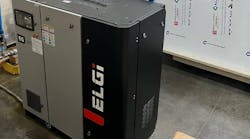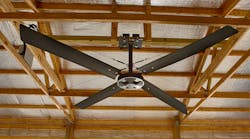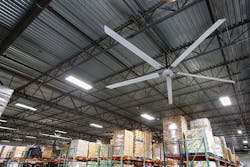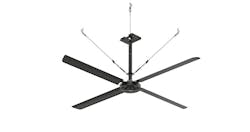Way back in 1886, the Statue of Liberty was completed and Coca-Cola was invented, but the most inviting and refreshing breakthrough was the creation of the first ceiling fan by John Hunter. The water-powered, belt-driven contraption cooled and ventilated hot, rank spaces that people previously accepted as normal.
Since then, the Memphis company has become a global leader in the consumer space with its rustic and contemporary fans circulating air in living rooms, kitchens and bedrooms across the world.
Now Hunter is spreading its portfolio – and fan blade size.
“If we’re going to be the world leader in fans, there’s a need to have different types of products and different paths to go to market,” explains Jeff Chastain, sr. vice president and general manager of Hunter Industrial brand, which targets manufacturing facilities, warehouses, and agricultural operations such as dairy farms.
Hunter Industrial was established four years ago with the Titan High-Volume, Low-Speed (HVLS) Fan, which has five blades and diameters of 14 to 24 feet. The 204-lb., 24-ft Titan has a 71 rpm max speed, but the downdraft it stirs up affects up to 22,500 ft².
“The Titan moves as much as 40 high-velocity fans can do,” Chastain says. There’s big energy consumption at play there. And think about maintenance of 40 fans vs. one fan.”
From breweries needing to reduce humidity to keep labels from slipping off the bottles or to dry off after a washout to dairy farms needing to cool the cows, which boosts their milk production, or expel volatile organic chemicals, the Titan has proven to be an invaluable climate changer.
“If you reduce drying time, you’re more productive because you can get back to work faster,” says Chastain.
The Nashville-based group decided last year to provide an option that is as indispensable, but at a lower price point. The ECO, short for economical, has four blades with eight size ranging from 8 to 24-foot diameters.
“We saw a gap of whitespace in our portfolio where, and based on customer feedback, we found people needed a less robust fan, in smaller diameters,” says Chastain. “[The ECO] provides more of an economical solution for someone who really wants an HVLS fan but doesn’t necessarily have the capital.”
These include warehouses, smaller manufacturers, and other closed environments where maintaining a comfortable atmosphere for workers is important, but isn’t as crucial to operations, like it would be in a food and beverage site
Major benefits of these direct-drive, 1-HP HVLS fans over gearbox-driven 2-HP fans include being 50% more efficient (based on AMCA 230-15 testing), 22% easier to install, 32% lighter, while using 50% fewer parts, the company says.
“We went through a pretty exhaustive process,” Chastain says. “We made sure it wasn’t just the right product for our customer, but that it could stand the test of time and be worthy of the Hunter brand.”
Hunter designed both models from the ground up to maximize efficiency and output in industrial spaces, while other manufacturers use “cannibalized tech,” Chastain says. After working with NASA, the fans use lightweight aerospace-grade aluminum blades optimized to move the most air at the lowest torque. This leads to less energy to operate, and Hunter can calculate a specific facility’s potential ROI based on the region’s kWh cost.
Installation of the plug-and-play, prewired fans also can be done by one person, and each fan is tested before shipping.
By ditching the gearbox, the fans also operate more quietly and without dripping oil or requiring as much maintenance.
“You’re not going to hear the background droning of gears downgrading a higher rpm motor to a lower rpm speed fan,” he says.
With ten different speeds, a facility manager can control set certain fans to lower speeds over workstations with loose papers, or higher (still only 156 max rpm for the 8-foot ECO) over hot equipment. Through the touchscreen HMI, fans can be controlled separately or together, with as many as 30 fans daisy-chained. Temperature probes near the fan on the ceiling and floor can also sense when the temperature changes and kick in. The system can also be integrated with a building management system for more specialized control.
Hunter Industrial Fans vs. Competition
For more information, visit: https://www.hunterindustrialfan.com/













